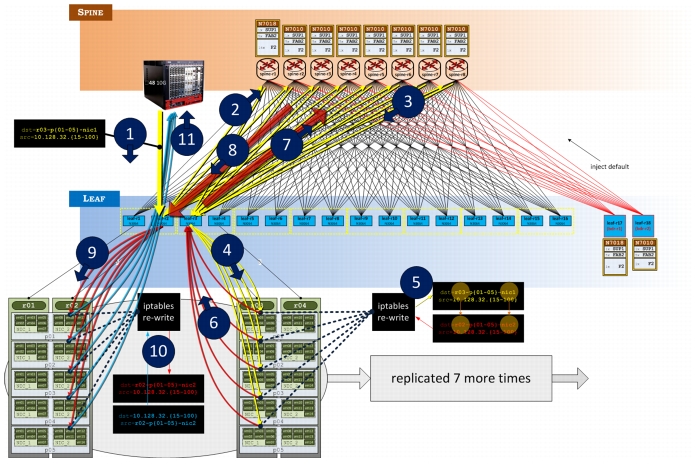

-
Massively Scalable Data Center (MSDC) Design and Implementation Guide
-
MSDC Design Architecture Preface
-
MSDC Reference Design Architecture
-
MSDC Solution Details and Testing Summary
-
Server and Network Specifications
-
Buffer Monitoring Code and Configuration Files
-
F2/Clipper Linecard Architecture
-
Competitive Landscape
-
Incast Utility Scripts, IXIA Config
-
Bandwidth Utilization Noise Floor Traffic Generation
-
Table Of Contents
Bandwidth Utilization Noise Floor Traffic Generation
Bandwidth Utilization Noise Floor Traffic Generation
Figure F-1 shows a walk-through of how noise traffic is generated by utilizing both IXIA and iptables on the servers:
Figure F-1 Noise (offset) Traffic Generation
1.
IXIA sends 6-8Gbps traffic down each of the 5 links connected to leaf-r2, with ip_dst set to servers hanging off leaf-r3. ip_src is set to a range owned by the IXIA ports.
2.
Since ip_dsts don't live off leaf-r2, traffic is attracted to Spine layer in ECMP fashion.
3.
Spine layer sends traffic to leaf-r3.
4.
Virtual servers (r03-{p01-p05}-n01) hanging off leaf-r3 receive traffic.
5.
Incoming traffic travels up the tcpip stack, the Linux bridge subsystem receives packets, then iptables (ip_forward) performs packet rewrite, changing ip_dst to be servers off leaf-r2.
6.
Packets reflected back to leaf-r3
7.
Since ip_dsts don't live off leaf-r3, traffic is attracted to Spine layer in ECMP fashion.
8.
Spine layer send traffic to leaf-r2.
9.
Virtual servers (r02-{p01-p05}-n02) hanging off leaf-r2 receive traffic.
10.
iptables re-writes ip_dst (IXIA) and ip_src (themselves).
11.
Traffic is forwarded back to IXIA.
Testing shows 99% linerate is achieved with this method, albeit at an [acceptable] 5% hit on server CPU resources. The desired noise floor was adjusted, as necessary, by tweaking packet rates on the IXIA - no changes required on the servers.

 Feedback
Feedback